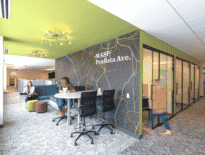Thad Minshall
Vice president of real estate and development, Connolly Brothers
Age: 40
Industry experience: 15 years
Connolly Brothers is touting its design-build services as a way for clients to avoid nasty surprises in an era of rising costs by closely coordinating designs what the budget allows. Thad Minshall puts his background in the development world to use in his current role as vice president at the Beverly-based construction managers, overseeing projects for outside clients as well as management of the company’s own portfolio of North Shore properties. Minshall joined the company in 2015 after a stint working for his family development firm in the Washington, D.C. area.
Q: Where are you seeing the biggest increases in project costs?
A: It’s across the board. Material availability due to COVID is still out of whack. We still have plants that are recovering, and some that are still shut down. There’s a backlog and they can’t keep things on the shelf. There’s lead time issues and supply issues, and people are raising prices. Labor costs continue to go up. You still have a labor shortage and there’s not enough skilled people to do the work we need them to do. It takes somebody years to become a skilled tradesman. Couple that with the demand for building right now, and it’s a perfect storm for rising costs.
Q: What does Connolly Brothers’ backlog look like following the effects of the pandemic in 2020?
A: There’s a ton of activity. We specialize in commercial and industrial, and institutional has slowed down because a lot of that is higher ed although now we’re seeing it kind of loosen up. People know the kids are getting back in the fall and want to get the “summer slammer” work done. The industrial market, which is our bread-and-butter, is on fire. We’re doing a ground-up flex industrial building off Route 114 in Middleton. The owner went spec and is in discussions for a portion of the building. That’s indicative of the market.
Everybody needs more space. The Amazons are sucking up the old industrial, and the old industrial in the city is being sucked up by multifamily developers and pushing everybody out. People are getting creative about where to put it. In Middleton, we removed 65,000 cubic yards of soil and ledge to make the site feasible. That’s a massive amount of dirt to move around, but where rents are going to be makes it feasible to do that.
Q: How tricky was the Great Marsh Brewing Co. project in Essex and how does the friction pile foundation system you used work?
A: The friction pile system is a way of supporting a building that’s not a traditional spread footing foundation. They call that property “Great Marsh” because it’s literally in the marsh. The building is essentially built on mud and peat moss. There’s nothing to hold it up.
[The piles] take a 6-inch–diameter steel pole and jam it into the ground until you get enough friction around that pile to hold up what you’re putting on top of it. If it’s 40, 60 or 80 feet, when you get to the point where the pile is not being driven, you can place your building on top of that. There’s 50 or 60 piles in that building. It all depends upon the bearing capacity of the soil underneath it, which is essentially nothing. If you put in a traditional spread footing, the building would be in the marsh in a matter of years.
Q: Are more clients opting for the design-build process and what are the advantages of that model?
A: Great Marsh was a design-build. We were involved from start to finish, including zoning and site feasibility. We did work with a designer who was hired by the owner, but we were the architect of record. They hired a designer to draw a pretty picture and hand us that and figure out how to build this thing. We do about 50 percent of our work design-build. It can be a speed issue. A lot of times, somebody doesn’t want to do the process of hiring an architect, bidding everything and coming back with a cost to do the project that’s out of alignment.
The beauty of design-build is we work hand-in-hand with the architect and owner to develop a budget first, and we design to the budget. We keep an eye throughout the entire process at what the budget is and what the owner can afford. You’re not coming in way out of whack on what you thought your budget was going to be, and it does allow you to save time. The key to it is creating trust between the owner and the construction team.
Q: What was your specialty in your previous role with Minshall Stewart Properties?
A: Repositioning class B projects in the Washington, D.C. area: offices and reskinning the building with new glass curtain wall or adding floors to the top of the building. You take an underperforming asset and improve it and lease it for more money and then you resell it. We did a building on K Street for the European Union. We bought the building, added three floors and leased them to the EU’s Embassy in D.C. We also did one on New York Avenue two blocks from the White House, reskinning the building with a number of high-profile tenants in place. Minshall Stewart was started by my dad in 1988 essentially doing that. He also dabbled in multifamily but by the time I started, we were doing primarily the urban core of Washington, D.C. I did a little bit of everything: property management, project management, asset management and acquisitions.
Q: What was the impetus for your move to Connolly Brothers in 2016?
A: My wife Janet is a Connolly and I’m married to the firm, as they say. Minshall Stewart was wrapping up in D.C. and my dad was retiring. My wife and I were looking at whether we wanted to stay in D.C. or be closer to family and maybe a better quality of life in Massachusetts. Jay and Steve [Connolly] needed some help on the real estate side. We own about 250,000 square feet of class A real estate in Beverly – industrial and warehouse – and I helped manage them and got involved on the construction side. We have two multitenant office buildings and two triple-net leased assets to a for-profit school, New England Academy, and a medical robotics company, that were purpose-built for those tenants.
Minshall’s Five Favorite North Shore Beaches:
- Crane Beach
- Wingaersheek Beach
- Crowninshield Island Beach
- Devereux Beach
- Good Harbor Beach




 |
| 


